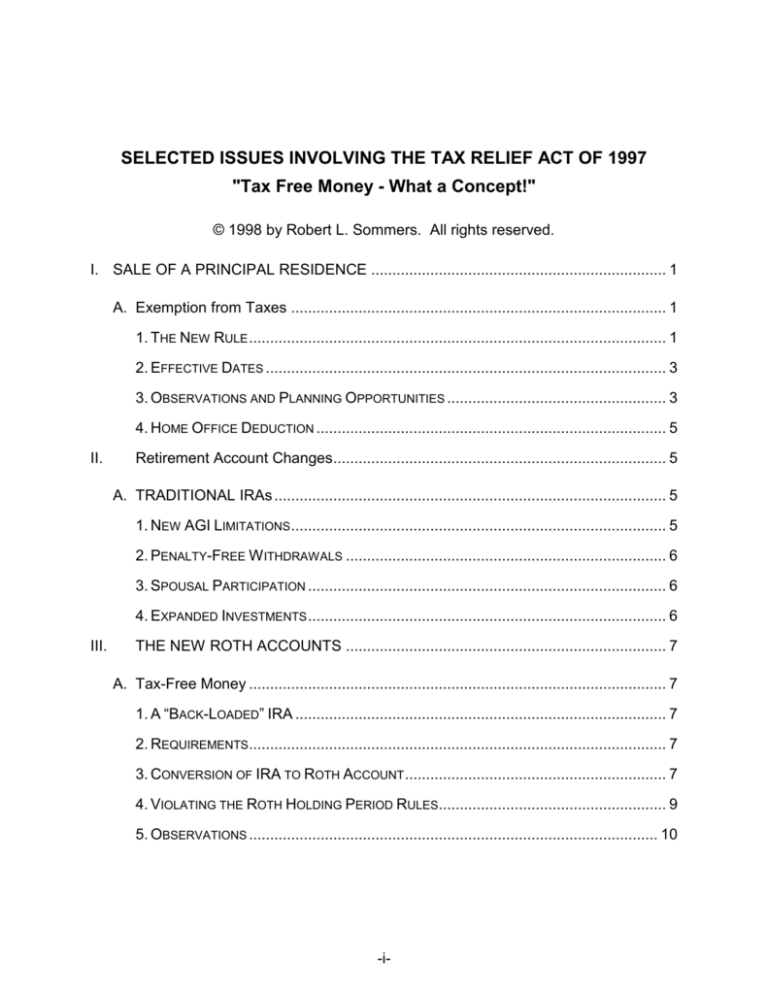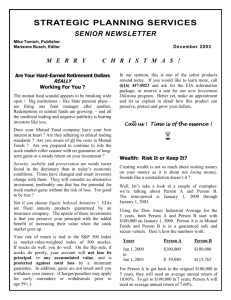
SELECTED ISSUES INVOLVING THE TAX RELIEF ACT OF 1997
"Tax Free Money - What a Concept!"
© 1998 by Robert L. Sommers. All rights reserved.
I. SALE OF A PRINCIPAL RESIDENCE ...................................................................... 1
A. Exemption from Taxes ......................................................................................... 1
1. THE NEW RULE ................................................................................................... 1
2. EFFECTIVE DATES ............................................................................................... 3
3. OBSERVATIONS AND PLANNING OPPORTUNITIES .................................................... 3
4. HOME OFFICE DEDUCTION ................................................................................... 5
II.
Retirement Account Changes............................................................................... 5
A. TRADITIONAL IRAs ............................................................................................. 5
1. NEW AGI LIMITATIONS ......................................................................................... 5
2. PENALTY-FREE W ITHDRAWALS ............................................................................ 6
3. SPOUSAL PARTICIPATION ..................................................................................... 6
4. EXPANDED INVESTMENTS ..................................................................................... 6
III.
THE NEW ROTH ACCOUNTS ............................................................................ 7
A. Tax-Free Money ................................................................................................... 7
1. A “BACK-LOADED” IRA ........................................................................................ 7
2. REQUIREMENTS................................................................................................... 7
3. CONVERSION OF IRA TO ROTH ACCOUNT .............................................................. 7
4. VIOLATING THE ROTH HOLDING PERIOD RULES...................................................... 9
5. OBSERVATIONS ................................................................................................. 10
-i-
SELECTED ISSUES INVOLVING THE TAX RELIEF ACT OF 1997
© 1998 by Robert L. Sommers. All rights reserved.
I.
SALE OF A PRINCIPAL RESIDENCE
A. Exemption from Taxes
1. THE NEW RULE
Profits from the sale of a principal residence after May 6, 1997, may be excluded up to
$250,000 for individuals and $500,000 for couples, provided the home was owned and
used as a residence for 2 of the 5 years preceding the sale.
a) The exclusion is limited to home sales occurring every 2 years or
longer.
(1) Note: Taxpayers with profits exceeding these limitations will pay
capital gains on sale. This will adversely affect those with gains over
$500,000 in their residences.
(2) Current tax-free rollover provisions (IRC Section 1034) and the
once-in-a-lifetime exclusion of $125,000 (IRC Section 121) have been
eliminated.
(3) Sales of a remainder interest may qualify for this exclusion.
b) Married couples who each own their principal residence may
exclude $250,000 on the sale of a residence, provided they filed joint
returns.
(1) If it is a new marriage and one spouse sold a residence within 2
years before the marriage, the other spouse may exclude up to
$250,000 in gain on a residence owned prior to the marriage.
c) A partial exclusion is available if a residence is sold prior to the twoyear-use requirement, because of a change in employment, health, or
unforeseen circumstances.
(1) Under the technical corrections bill, taxpayers apply the full
exclusion ($250,000 or $500,000) to the percentage of use which is
determined by the months of use prior to sale, divided by 24.
(2) Example: If a taxpayer eligible for a $250,000 exclusion meets
the ownership and use test for 12 months, then sells his home for a
$100,000 profit, the entire amount would be excluded (12/24 months x
$250,000 = $125,000 maximum available exclusion).
-1-
d) For those living in a nursing home, the ownership and use test is
lowered to 1 out of 5 years prior to entering a facility.
(1) Time spent in the nursing home still counts toward ownership
time and use of the residence.
(a) For example, if a taxpayer owns and lives in a home for 1
year, resides in a nursing home for 10 years, then sells the
residence, the exclusion will apply.
e) The exclusion does not apply to depreciation allowable on
residences after May 6, 1997. Therefore, taxpayers should reconsider
using a portion of their homes as offices, since the depreciation will be
taxed at 25%.
(1) The home-office deduction will continue to be advantageous for
those in the highest tax bracket who do not plan to sell their homes for
many years, or those with gain exceeding the exclusion amounts.
(a) For instance, if a married taxpayer’s gain exceeds
$500,000, then the excess will be taxed at 20%. The 25% tax
on the depreciation amounts to a 5% tax increase, but the
current deduction could be worth as much as 39.6% on the
federal tax return.
(2) The depreciation subject to a 25% tax, however, should not
diminish the $500,000 tax-free portion.
(a) Example: If a married couple sells a home with an
adjusted basis of $100,000 for $750,000, and $50,000 is
subject to recapture, their taxes should be determined as
follows: Taxable gain: $750,000 - $100,000 = $650,000.
Amount subject to 25% capital gain = $50,000; Amount tax-free:
$500,000; Amount subject to 20% capital gain = $100,000.
f) The exclusion is not available to those who expatriate under IRC
Sec. 877(a)(1) if they gave up their citizenship to avoid taxes.
g) Widowed taxpayers may tack on the deceased spouse’s period of
ownership and use.
h) Divorced taxpayers may include the period of ownership or use of
the spouse or former spouse.
(1) For instance, if a residence is transferred from a husband to his
wife pursuant to a divorce decree, the wife may add the husband’s
period of ownership to meet the 2-year ownership requirement.
(2) Similarly, if the husband continues to own the residence, but the
wife has exclusive use of it, the husband may include his former
spouse’s use to meet the 2-year use requirement.
-2-
2. EFFECTIVE DATES
a) The effective date is for all sales or exchanges of principal
residences occurring after May 6, 1997.
b) Taxpayers may elect to apply present law to sales occurring:
(1) after August 5, 1997;
(2) before August 5, 1997, pursuant to a binding contract entered
into before that date; or
(3) where the replacement property was acquired before the date
of enactment and the rollover provisions would otherwise apply.
3. OBSERVATIONS AND PLANNING OPPORTUNITIES
a) Those with huge gains should consider converting a portion of their
home to legitimate investment property or having their children meet the
ownership and use tests.
(1) For example, a married taxpayer’s residence has a potential
gain of $750,000. By converting 1/3 into investment property, then
selling the 2/3 residential portion for $500,000, and using the Section
1031 tax-free exchange provisions for the 1/3 investment portion, the
entire transaction becomes tax-free.
b) Suppose a single man who has lived in his residence with his
girlfriend for the past 2 years, sells his principal residence on October 1,
1997 for a $500,000 profit. He meets the ownership and use test, and his
girlfriend also meets the use test.
(1) If they get married by midnight December 31, 1997, they are
eligible to file a joint return for 1997, and therefore, he may exclude the
entire $500,000 of profit.
c) The two-year period begins when a person acquires the principal
residence by purchase, gift or inheritance.
(1) If the new residence was acquired in a transaction in which gain
was not recognized under former IRC Section 1034 (a tax-free rollover
of a principal residence), taxpayers may include periods of ownership
and use of those residences, provided the previous gain was rolled
over (under Section 1034) into the current residence.
d) Taxpayers who qualify for the $500,000 residence exclusion, but
whose capital gain exceeds $500,000 could shift any potential gain to
their child through the use of the annual gift tax exclusion and Unified
Estate and Gift Tax Credit (worth $625,000 in 1998).
-3-
(1) If the child owns and lives in the residence for 2 of the next 5
years prior to its sale, he will qualify for the residence exclusion as
well.
(2) Example: If the home is worth $1 million and the adjusted basis
is $250,000, the potential gain is $750,000. The residency exclusion
applies to $500,000, leaving a taxable gain of $250,000. If a gift of a
one-third interest in the property is made, then the beneficiary’s gain
will be $250,000.
(3) The home may be sold two years later for $1 million without
capital gains tax to either the taxpayer or the beneficiary since the
capital gain on each portion will be shielded by the residence
exclusion.
(4) The gift tax computation is tricky. Although one-third of $1
million is $333,333, the taxpayers might be entitled to a fractional
interest discount (assume 30%), thereby reducing the gift’s value by
$233,333 ($333,333 - 30% = $233,333).
(a) After application of the annual gift tax exclusion of
$20,000, the $213,333 balance would easily be sheltered by the
Unified Credit (husband and wife may each reduce their Unified
Credit by $116,666.50).
e) Note: Taxpayers may combine a home-equity loan with making a
gift to a child to minimize the gift taxes.
(1) Example: Suppose the couple in the above example borrows
$750,000 against the home, then transfers the one-third interest to
their son. The son’s interest is subject to the outstanding liability and
he has no legal claim against his parents to repay his share of the
liability.
(a) Under these conditions, the gift would be measured by
the equity in the property transferred ($333,333 - $250,000 =
$83,333 equity).
(b) After applying a fractional interest discount of 30%, the
gift’s value is reduced to $58,333. The annual exclusion
eliminates $20,000 of the gift’s value and the remaining $38,333
is sheltered by the Unified Credit (husband and wife may each
reduce their Unified Credit by $19,167).
f) Taxpayers may take advantage of the residency exclusion without
actually selling their residence by borrowing against the equity up to
$250,000 ($500,000 for husband and wife), and later repay the loan from
the sales proceeds.
-4-
(1) The residency exclusion eliminates the capital gain.
(a) Note: With a home equity loan, only the interest paid on
$100,000 of loan principal is tax-deductible.
(2) For example: An individual purchases a home for $250,000
with $50,000 down and a $200,000 mortgage (deed of trust). The
home’s value increases to $500,000.
(3) The taxpayer then borrows $250,000 on the home’s equity and
spends the funds. When the home is sold for $500,000, the taxpayer
repays the lenders without incurring a tax on the $250,000 profit. The
repayment occurred with tax-free funds.
g) A taxpayer may sell the remainder interest in his residence to an
independent third party. When a remainder interest is sold, the purchaser
acquires full rights to the home upon the death of the seller. Therefore,
the taxpayer may continue to live in the home during the rest of his life.
(1) The person acquiring the residence cannot be a member of the
taxpayer’s family or other related person as defined in IRC Section
267(b) or 707(b).
4. HOME OFFICE DEDUCTION
a) The home office deduction has been expanded to include an office
used to conduct administrative and managerial activities of the taxpayer’s
trade or business, provided there is no other fixed location where the
taxpayer conducts these services.
(1) This provision effectively overrules the Supreme Court decision
in Commissioner v. Soliman, 113 S. Ct. 701 (1993) which disallowed a
home office deduction to an anesthesiologist who practiced at several
hospitals, but used a room in his home exclusively for administrative
and managerial activities related to his profession.
b) Taxpayers should exercise caution regarding the home office
deduction, given the adverse treatment of real estate depreciation.
(1) Depreciation deductions incurred through a home office
deduction will be taxed at a 25% capital gains rate, whereas, gain from
the sale of a principal residence will be untaxed up to $500,000 for
couples ($250,000 for individuals) under the new rules.
II.
RETIREMENT ACCOUNT CHANGES
A. TRADITIONAL IRAs
1. NEW AGI LIMITATIONS
-5-
a) AGI limitations for contributions to IRAs (currently $25,000 for
individuals and $40,000 for couples) will increase at $5,000 per year for
individuals and $10,000 per year for couples in 1998, 2002, 2003 and
2004.
(1) After 2004, the AGI limitations will be $50,000 for individuals
and $80,000 for joint filers.
2. PENALTY-FREE W ITHDRAWALS
a) Penalty-free withdrawals are permitted for first-time home
purchases to a maximum of $10,000 or educational expenses (without
limitation).
(1) Qualified first-time homebuyer distributions may withdraw up to
$10,000 which must be used within 120 days to pay costs (including
reasonable settlement, financing or closing costs) of acquiring,
constructing or reconstructing the principal residence of the first-time
homebuyer.
(2) A first-time homebuyer is someone who has not owned a home
for the 2-year period ending on the date the home is purchased.
(3) The eligible homebuyers include the IRA (or Roth IRA) owner,
owner’s spouse, child, grandchild or ancestor of the owner or spouse.
(4) There is a 10% penalty if the money withdrawn is not used for
the home purchase, but the funds may be recontributed to a Roth IRA
within 120 days, without adverse tax consequences.
3. SPOUSAL PARTICIPATION
a) If one spouse is an active participant in an employer-sponsored
retirement plan, the other spouse is now eligible for an IRA deduction to a
maximum of $2,000.
b) This benefit phases out for couples with AGI between $150,000
and $160,000.
4. EXPANDED INVESTMENTS
a) Beginning January 1, 1998, the general prohibition against
investment in collectibles has been lifted for certain platinum coins and
certain gold, silver, platinum or palladium bullion.
-6-
III.
THE NEW ROTH ACCOUNTS
A. Tax-Free Money
1. A “BACK-LOADED” IRA
a) The new “Roth IRA” account is an IRA with a twist: Investors
cannot deduct the contributions, but earnings accumulate tax-free.
However, unlike a traditional IRA which had distributions that were tax
deferred, the IRA Plus distributions will never be taxed.
b) Contributions to the Roth IRA must be made with after-tax dollars.
There is an overall annual limitation of $2,000 for contributions to all IRAs
for individuals and $4,000 for couples. Contributions must be made by
April 15th of the following year.
c) Note: California has conformed to the Roth IRA, including the IRAto-Roth rollover provisions. SB 1233 (Stat. 1997, Ch 612); R&T Section
17507.6.
d) Note: Internet resource:
“www.rothira.com” is an excellent
resource for information on Roth IRAs, including Roth vs. IRA conversion
calculators.
2. REQUIREMENTS
a) Penalty-free withdrawals cannot occur until the account is at least 5
years old.
b) Penalty-free distributions may be made to —
(1) The owner after age 59 ½;
(2) The designated beneficiary after the owner’s death;
(3) The owner prior to age 59 ½, if the owner is disabled; and
(4) The owner prior to age 59 ½ for qualified first-time homebuyer
expenses, subject to a $10,000 lifetime cap for the Roth IRA owner or
his spouse, child, grandchild or ancestor. IRC Sec. 408A(d)(2)(D).
c) There is a phase-out of eligibility starting at AGIs of $95,000 to
$110,000 for individuals, and $150,000 to $160,000 for couples.
3. CONVERSION OF IRA TO ROTH ACCOUNT
a) Investors with regular IRAs may convert them to Roths.
-7-
(1) Employer-sponsored plans, such as 401K and SEP IRAs
cannot be converted directly to a Roth. Taxpayers must first receive a
distribution from their plan provider under the terms of the plan and
then rollover the distribution to an IRA.
(a) Then, taxpayers may convert the newly created IRA into
a Roth. However, if taxpayers meet income limitations, they
may contribute annually to a Roth, even if they have an active
SEP, 401K or other non-IRA retirement plan.
(2) Note: There is no tax difference between an IRA distribution
that taxpayers receive and then deposit (rollover) to a Roth or an IRA
account that is “converted” directly to a Roth.
b) The conversion will be taxed as an IRA distribution, but without
penalty for early withdrawal.
(1) The Roth is valued on the date of conversion or rollover
because taxpayers are treated as receiving a full distribution at that
time.
(2) Taxpayers cannot designate the non-deductible portion of an
IRA for rollover treatment. They must determine the proportion of
after-tax investment to the IRA’s total value.
(3) For example, if all the after-tax contributions equal $30,000 and
the account is now worth $50,000, the IRA consists of a 60% after-tax
investment ($30,000/$50,000) and 40% ($20,000) tax-deferred
earnings.
(4) This ratio applies to the money transferred to a Roth, regardless
of the amount.
(a) However, taxpayers may use the four-year-averaging
rule to divide the $20,000 taxable amount into four $5,000
annual portions.
(b) Or, they may choose to rollover a lower amount, say only
$30,000, but the 60/40 ratio still applies: In that case, $18,000
(60%) will be considered a non-taxable distribution, with a
taxable balance of $12,000 (eligible for four-year averaging).
(5) Contributions made to existing IRAs with after-tax dollars are
not taxed on this rollover.
c) Taxpayers with less than $100,000 in AGI (determined prior to the
conversion) are eligible to rollover an IRA into an IRA Plus account. This
limitation applies to both single and joint filers.
-8-
(1) Note: The statutory language uses the singular, “taxpayer,”
when discussing the $100,000 AGI limitation (“…the taxpayer’s
adjusted gross income…” under IRC Sec. 408A).
(a) One commentator has suggested that the $100,000 AGI
limitation might apply to a husband and wife separately. Estate
Planning March/April 1998, pages 104-106.
(b) However, the “Blue Book”, General Explanation of Tax
Legislation Enacted in 1997 by the Joint Committee of Taxation,
page 47, states that the AGI limitation applies to the combined
income of both husband and wife.
d) For those over age 70 ½, the IRS contends that any required IRA
minimum annual distribution is part of the current year’s AGI and is not
eligible for Roth rollover treatment.
(1) Further, this income is counted towards the $100,000 AGI
limitation for Roth rollovers.
(a) Provided the taxpayer is eligible, the Roth rollover rules
will apply to the balance of an IRA as follows: If an IRA has
$120,000 and the minimum distribution is $12,000 in 1998, the
taxpayer may rollover the $108,000 balance to the Roth before
1999.
e) Many taxpayers who convert to a Roth will not know whether their
AGI exceeds $100,000 until after December 31, 1998.
(1) The pending Technical Corrections Act will allow taxpayers to
convert the Roth back to an IRA so that the rollover, in effect, never
happened. If this conversion is completed before the due date for
filing the 1998 tax return, including extensions, then there will be no
penalties for the attempted rollover.
f) If the rollover is completed in 1998, the tax is spread ratably over 4
years. Assuming an IRA is fully taxable (it consists of previously
deductible contributions and untaxed earnings), a $108,000 IRA account
will add $27,000 to gross income in 1998, 1999, 2000 and 2001.
g) The Technical Corrections Act provides that if a taxpayer dies
during the four-year tax-averaging period, all taxes owed from the rollover
become payable on the taxpayer’s last tax return, unless the Roth
beneficiary is the decedent’s spouse. In that case, the four-year
averaging continues.
4. VIOLATING THE ROTH HOLDING PERIOD RULES
-9-
a) Contributions to a Roth, including rollover contributions, require a
five-year holding period before distributions become tax-free.
(1) To prevent taxpayers from converting an IRA to a Roth merely
to gain the advantage of the four-year-averaging rule (no such benefit
exists for direct IRA distributions), there is a 10% penalty for
distributions during the holding period when averaging.
(2) Note: The four-year-averaging rules continue to apply.
premature distribution will not cancel this benefit.
A
b) Assume a taxpayer rolls over a $50,000 IRA in 1998, consisting of
$30,000 of after-tax contributions and $20,000 of pre-tax contributions
(taxable portion), and takes a $10,000 Roth distribution in the year 2000.
The pending Tax Technical Corrections Act of 1997 would treat the
rollover and subsequent distribution as follows:
(1) The distribution first comes from the taxpayer’s original $20,000
taxable portion. Therefore, the entire $10,000 becomes part of the
taxpayer’s taxable income.
(2) If the taxpayer is under age 59 ½, there is an additional 10%
“early withdrawal” penalty.
(3) To clarify, the full $10,000 distribution is gross income. Plus,
taxpayers could owe a 10% ($1,000) early withdrawal penalty and
another 10% ($1,000) penalty for failing to abide by the four-yearaveraging rules.
5. OBSERVATIONS
a) A taxpayer may contribute to a Roth IRA even if he or she is
covered by another retirement plan.
b) Assets held in a 401K plan are not eligible for rollover treatment
unless they are rolled over to a regular IRA first (which can only occur if
there is a distributing event in the 401K plan), and then from the rollover
IRA to the Roth IRA.
c) Should a taxpayer pay the up-front tax to achieve tax-free
distributions? Payment of the up-front tax makes sense in the following
situations —
(1) If the taxpayer believes tax rates will be higher in the future;
(2) If the taxpayer has a large estate and payment of the tax will
reduce the size of the estate;
-10-
(3) If the named beneficiary is young and distributions are within
the timing and control of the beneficiary, then the tax-free build up
could be tremendous.
(a) There is no prohibition to using the IRA qualified trusts
for beneficiaries of a Roth.
(b) Because there is not a current distribution requirement
with a Roth, some commentators have suggested that a gift to
an irrevocable trust is possible, thereby eliminating income and
estate taxes on the future appreciation. Estate Planning, supra.
pages 99 - 104.
(i)
Transferring a Roth to an irrevocable trust,
however, appears to violate the requirement that the taxpayer
remain the owner during the taxpayer’s lifetime.
(ii)
A transfer to a trust could be characterized as a
distribution to the owner, and then a transfer of the proceeds
to the trust. Although the distribution to the taxpayer might be
tax-free, the trust would not continue to enjoy tax-free
accumulation and distribution of the corpus.
(c) Also, the income level of the beneficiary is a significant
factor. For instance, it makes sense to leave a Roth IRA to a
beneficiary who is consistently in the highest tax bracket, such
as a highly paid professional or entertainer.
-11-
-i-




